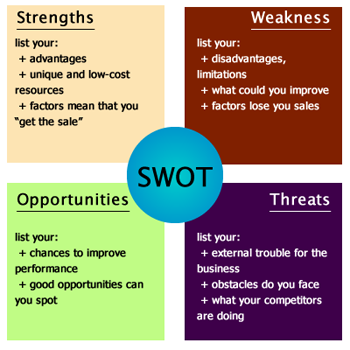Strengths, Weaknesses, Opportunities, and Threats involved in a project or in a business venture.
If you want to try it out without entering your email address, please use our public SWOT Analysis Canvas Demo for a first impression.

More about the SWOT analysis
SWOT Analysis
SWOT Analysis is a very useful technique in business, it is an acronym that helps to identify and understand your Strengths and Weaknesses, and also to identify both the Opportunities open to you and the Threats you might be facing. SWOT analysis is a simple but powerful resource to help you develop your business strategy, either you are building a start-up or developing an existing company. It is a superb masterpiece which every organization needs to get through to greater heights of success.
The Strengths (S) and Weaknesses (W) are normally considered as internal factors of the organization that you can control while Opportunities (O) and Threats (T) are external factors over which you have absolutely no influence or control.
Simple as it seems, the SWOT Analysis is a giant volume. Let us look at a summary of the parameters of SWOT Analysis as detailed in the book:
Strengths
Strengths are the individual qualities that help the firm to achieve its objectives. These strengths could be tangible or intangible and through them you can have continued success in the firm. Most of them lie in what the employees possess and include process capabilities, competency levels, products and services, brand loyalty, financial resources and customer goodwill. The organizational strengths may include a broad product line, committed employees, absence of debt and adequate financial resources.
Strengths are internal inherent abilities, comparable to having unfair advantage over competitors and they should be a part of the positive attributes of your company. These are things that are within your control. Consider your strengths from both an internal perspective, and from the perspective of your customers.
When thinking about your strengths, consider them relative to your competitors. For example, if all of your competitors provide high-quality products, then a high-quality production process is not a strength in your organization's market, it's a necessity.
Having natural talent is a very good point to begin with, however, it takes practice, learning, experience and genuine feedback to develop that talent into strength.
If you have a hard time identifying your strengths, write down a list of your business' attributes. Some of these will hopefully be strengths!
- What advantages does your business have?
- What do you do better than others?
- What is your unique value proposition?
- What do customers see as your strengths?
Weaknesses
In SWOT analysis, “W” means Weaknesses, they are the attributes of a business that gives disadvantage relative to others. Weaknesses are all the aspects you do not perform well in. SWOT weaknesses can prevent you from achieving laid out company goals and objectives. The weaknesses of a company include its attributes, resources and internal processes that have adverse effects on its output, activities, tasks and development processes at the operational and strategic levels. Consequently, weaknesses negatively affect the effective implementation of the organizational goals and limit the possibilities for success. Businesses with more weaknesses than strengths cannot afford to undergo wide range of development activities in situation of dominating threats. Examples may include; outdated facilities, unmotivated employees, strong brand recognition of competitors.
Weaknesses are very qualities that the firm from achieving our objectives or our potential to the fullest. They fall below the line of standards we want. They include insufficient research and development for the firm’s products and services, a depreciating set of machinery, poor decision making and a narrow product range. However, the good news about weaknesses is that they can be controlled, minimized or eliminated totally altogether. Organizational weaknesses include wastage of raw materials, high employee turnover and huge debts.
Opportunities
In SWOT analysis, “O” means Opportunities, they are a series of different circumstances at a given time that most likely result in positive outcomes if properly leveraged.
Opportunities are often said to be external, which means that they cannot be defined the same way Strengths are, no matter how hard people try, they cannot create opportunities, they can only determine how to position themselves to take advantage of them and gain maximum benefit from them, or decide against leveraging them.
The basic way to remember this is that opportunities are positive and external: they benefit those who have prepared and can take due advantage of them at that point in time, but they cannot be produced when desired.
Opportunities are the avenues for improvement and success which present themselves in the business environment. Once recognized and acted upon, the organization can gain a competitive advantage over its competitors. The firm should always be on the lookout to avoid failing to recognize them. Business opportunities may arise as a result of competition, from the market, the nature of the industry and the government.
Threats
In SWOT analysis, “T” means Threats, a threat is an external factor that may affect the operations and output of your business. The most glaring negativity threats might have on a business would be a reduction in its corporate sales. Usually, a business faces many threats, other than competition, when operating its affairs.
For example, the tobacco industry has experienced and is expected to continue to experience numerous threats. American and Canadian Medical Associations have conducted many experiments that suggest smoking leads to many illnesses and deaths. This threat certainly reduced the number of North American smokers and thus the tobacco industry undoubtedly experienced revenue reductions. Other major threats to the tobacco industry would be the ban on smoking in federal buildings and on commercial airlines. These threats do not necessarily reduce the number of North American smokers, instead, they reduce the number of tobacco products being consumed during working hours and flying time, for instance.
Threats arise when the efforts of the firm to attain a high level of profitability and reliability are jeopardized. They normally put the survival and stability of the firm to test and they are often incontrollable. They can be seen when there are excessive price wars in the industry, constantly changing prices, unfavorable laws and regulations, cutthroat competition, constantly changing technology and a lot of undue unrest among the firm’s employees.
We highly recommend the SWOT Analysis because it not only enables you to know where you are as a firm but also where you can be in the future. As such, SWOT Analysis:
- Helps a firm to identify its core competencies
- Helps a firm to focus on the future given its past and present condition
- Enables a firm to make a U-turn of its weaknesses
- Helps a firm to build its strengths
- Points to the opportunities that a firm can maximize to reap maximum gains
- Is a source of strategic planning as well as marketing
- Helps the firm to redefine and set its overall objectives

